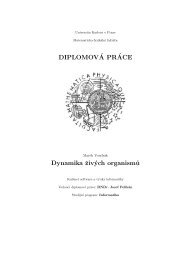Bachelor Thesis - Computer Graphics Group
Bachelor Thesis - Computer Graphics Group
Bachelor Thesis - Computer Graphics Group
Create successful ePaper yourself
Turn your PDF publications into a flip-book with our unique Google optimized e-Paper software.
The function supposed to invoke the gesture-event or window-ignored callback<br />
checks whether the current thread is the message thread. If not, the code is<br />
being executed in context of a foreign process. By sending a message to the<br />
hidden window, the context switches to our application, where the message is<br />
handled. Now the same function is dispatched, but now running in the correct<br />
context and thus it is able to call the callback function this time directly.<br />
The timeout feature is implemented using a timer. There are two types of<br />
timers in Windows, standard and multimedia. Standard timers have been tried<br />
first. The main advantage of the multimedia timer [22] being more accurate is<br />
not required. However, problems have been experienced with standard timer<br />
behavior, while the multimedia one worked correctly. Hence, this type of timer<br />
has been selected. The code setting and clearing the timer has to be executed<br />
in the context of the main application. Therefore, a timer handler routine is<br />
called just before the gesture-event callback function. We have to use a single<br />
shot timer to prevent multiple invocations of the handler function. The timer is<br />
started on the GestureBegin event, restarted on every GestureMove event<br />
a finally destroyed on all other events. If the timer handler procedure happens<br />
to be executed, the timeout interval has been reached. A GestureCancel<br />
event is sent to the main application.<br />
4.5 Issues experienced<br />
The development of the gesture capture library proved a challenge as predicted<br />
in the Introduction. Some parts of the actual implementation had to be revised<br />
a few times, to solve some problems, which have been discovered only when<br />
the fully functional application started to be used practically. The experienced<br />
issues include:<br />
• some kinds of windows are problematic, such as the Start menu. These<br />
have to be detected reliably and ignored automatically. It is not an<br />
easy task though, window classes and styles have to be checked. The<br />
detection has to be as accurate as possible. Otherwise, windows that use<br />
a non-typical combination of attributes may be accidentally ignored<br />
• useless mouse movement events are being reported in some cases. In<br />
some cases, the mouse-hook callback is being called periodically, even<br />
if the mouse cursor does not move, reporting the same cursor position.<br />
The last position has to be saved and compared with the “new” position<br />
every time, to avoid reporting fake events to the main application<br />
• to support mouse button swapping correctly, logical and physical buttons<br />
had to be distinguished. The logical button identifiers, reported to<br />
the mouse-hook callback function are swapped. However, the physical<br />
27
















